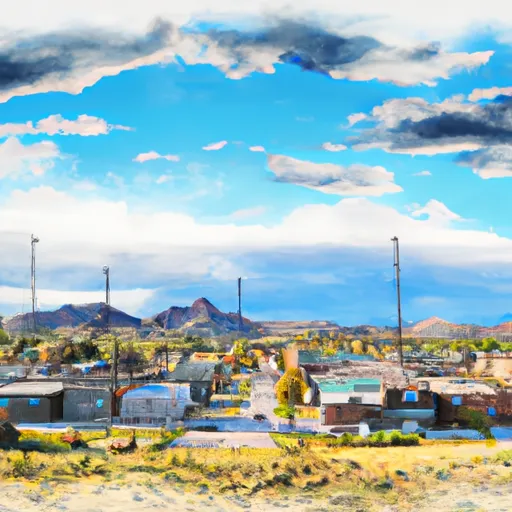-
 Snoflo Premium
Snoflo Premium
Get unlimited access to all our content
With no Ad interruptions! - Start Your Free Trial Login with existing account
Last-Chance
Eden Index
Climate
8.5
•
Recreation
•
Community
•
Safeguard
3.4/10

Last-Chance, Colorado is a small town nestled in the eastern plains of the state. Known for its unique climate and diverse outdoor recreation opportunities, Last-Chance offers a delightful experience for nature enthusiasts. The town experiences a semi-arid climate, characterized by hot summers and cold winters. Summers are typically warm with temperatures averaging in the mid-80s Fahrenheit, while winters can be chilly with temperatures dropping below freezing.
Hydrologically, Last-Chance is situated near the South Platte River, which flows through the town. The river acts as a vital water source and offers opportunities for activities like fishing, boating, and kayaking. Additionally, Last-Chance boasts several reservoirs and lakes in the surrounding areas, providing further water-based recreational options.
Outdoor enthusiasts will find plenty to do in Last-Chance. The town is surrounded by vast grasslands, allowing for activities such as hiking, camping, and birdwatching. There are also designated trails for horseback riding and off-roading. For those seeking a more adrenaline-filled adventure, Last-Chance offers opportunities for hunting, ATV riding, and even hot air ballooning.
In summary, Last-Chance, Colorado presents a unique climate with hot summers and cold winters. Its hydrology constituents include the South Platte River and surrounding reservoirs, allowing for various water-based activities. With its vast grasslands and designated trails, Last-Chance offers a wide range of outdoor recreation opportunities for nature enthusiasts.
What is the Eden Index?
The Snoflo Eden Index serves as a comprehensive rating system for regions, evaluating their desirability through a holistic assessment of climate health, outdoor recreation opportunities, and natural disaster risk, acknowledging the profound impact of these factors on livability and well-being.
Climate Health Indicator (CHI): 8.5
Last-Chance receives approximately
390mm of rain per year,
with humidity levels near 69%
and air temperatures averaging around
10°C.
Last-Chance has a plant hardyness factor of
5, meaning
plants and agriculture in this region thrive during a short period during spring and early summer. Most
plants will die off during the colder winter months.
By considering the ideal temperature range, reliable water supplies, clean air, and stable seasonal rain or snowpacks, the Climate Health Indicator (CHI) underscores the significance of a healthy climate as the foundation for quality living.
A healthy climate is paramount for ensuring a high quality of life and livability in a region, fostering both physical well-being and environmental harmony. This can be characterized by ideal temperatures, reliable access to water supplies, clean air, and consistent seasonal rain or snowpacks.
Weather Forecast
Streamflow Conditions
South Platte
Area Rivers
South Platte
Snowpack Depths
South Platte
Reservoir Storage Capacity
South Platte
Groundwater Levels
Recreational Opportunity Index (ROI):
The Recreational Opportunity Index (ROI) recognizes the value of outdoor recreational options, such as parks, hiking trails, camping sites, and fishing spots, while acknowledging that climate plays a pivotal role in ensuring the comfort and consistency of these experiences.
Access to outdoor recreational opportunities, encompassing activities such as parks, hiking, camping, and fishing, is crucial for overall well-being, and the climate plays a pivotal role in enabling and enhancing these experiences, ensuring that individuals can engage in nature-based activities comfortably and consistently.
Camping Areas
| Campground | Campsites | Reservations | Toilets | Showers | Elevation |
|---|---|---|---|---|---|
| Riverside RV Park | 25 | 4,266 ft | |||
| Brush Memorial RV Park | 24 | 4,235 ft | |||
| Hugo City Park | 10 | 5,040 ft |
Catastrophe Safeguard Index (CSI):
The Catastrophe Safeguard Index (CSI) recognizes that natural disaster risk, encompassing floods, fires, hurricanes, and tornadoes, can drastically affect safety and the overall appeal of an area.
The level of natural disaster risk in a region significantly affects safety and the overall livability, with climate change amplifying these risks by potentially increasing the frequency and intensity of events like floods, fires, hurricanes, and tornadoes, thereby posing substantial challenges to community resilience and well-being.
Community Resilience Indicator (CRI):
The Community Resilience Indicator (CRI) recognizes that education, healthcare, and socioeconomics are crucial to the well-being of a region. The CRI acknowledges the profound impact of these elements on residents' overall quality of life. By evaluating educational resources, healthcare accessibility, and economic inclusivity, the index captures the essential aspects that contribute to a thriving community, fostering resident satisfaction, equity, and social cohesion.

